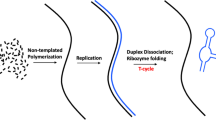Summary
It has previously been shown that the formation of GU base pairs in RNA copying processes leads to an accumulation of G and U in both strands of the replicating RNA, which results in a non-random distribution of base triplets. In the present paper, this distribution is calculated, and, using the χ2-test, a correlation between the distribution of triplets and the amino acid composition of the evolutionarily conservative interior regions of selected globular proteins is established.
It is suggested that GU wobbling in early replication of RNA could have led to the observed amino acid composition of present-day protein interiors. If this hypothesis is correct, the GU wobbling must have been very extensive in the imprecisely replicating RNA, even reaching values close to the critical for stability of its double-helical structure. Implications of the hypothesis both for the evolution of the genetic code and of proteins are discussed.
Similar content being viewed by others
References
Archer R (1974) Recent discoveries in the evolution of proteins. Angew Chem Intern Edit 13:185–197
Anfinsen CB (1973) Principles that govern the folding of protein chains. Science 181:223–230
Barricelli NA (1977) On the origin and evolution of the genetic code. I. Wobbling and its potential significance. J Theor Biol 67:85–89
Barricelli NA (1980) A note on uracil-guanine pairing in RNA molecules. Evol Theor 5:29–33
Brack A, Orgel LE (1975) β-structures of alternating polypeptides and their possible evolutionary significance. Nature 256:383–387
Bychkova VE, Semisotnov GV, Ptitsyn OB, Gudkova OV, Mitin YuV, Anufrieva EV (1980) The compact structure of statistical copolymers composed of hydrophobic and hydrophilic amino acid residues. J Mol Biol 14:191–278
Chothia C (1975) Structural invariants in protein folding. Nature 254:304–308
Chothia C (1976) The nature of accessible and buried surfaces in proteins. J Mol Biol 105:1–14
Eigen M, Schuster P (1978) A principle of natural self-organization. Part C: The realistic hypercycle. Naturwissenschaften 65:341–369
Eigen M, Winkler-Oswatitsch R (1981) Transfer RNA, an early gene? Naturwissenschaften 68:282–292
Epstein CJ (1966) Role of the amino acid “code” and of selection for conformation in the evolution of proteins. Nature 210:25–28
Gō M, Miyazawa S (1980) Relationship between mutability, polarity and exteriority of amino acid residues in protein evolution. Int J Peptide Protein Res 15:211–224
Goldberg AL, Wittes RE (1966) Genetic code: aspects of organization. Science 153:420–424
von Heijne G, Blomberg D, Baltscheffsky H (1978) Early evolution of cellular electron transport: molecular models for ferredoxin-rubredoxin-flavodoxin region. Orig Life 9:27–37
Janin J, Wodak S, Levitt M, Maigret B (1978) Conformation of amino acid side-chains in proteins. J Mol Biol 125:357–386
Janin J (1979) The protein kingdom: a survey of the threedimensional structure and evolution of globular proteins. Bull Institut Pasteur 77:337–373
Jukes TH (1973a) Arginine as an evolutionary intruder into protein synthesis. Biochem Biophys Res Commun 53:709–714
Jukes TH (1973b) Possibilites for the evolution of the genetic code from the preceding form. Nature 246:22–26
Jungck JR (1978) The genetic code as a periodic table. J Mol Evol 11:211–224
Jurka JW (1977) On replication of nucleic acids in relation to the evolution of the genetic code and of proteins. J Theor Biol 68:515–520
Levitt M, Greer J (1977) Automatic identification of secondary structure in globular proteins. J Mol Biol 114:181–239
Ohlsson I, Nordström B, Bränden CI (1974) Structural and functional similarities within the coenzyme binding domains of dehydrogenases. J Mol Biol 38:381–393
Orgel LE (1972) A possible step in the origin of the gentic code. Isr J Chem 10:287–292
Richardson JS (1977) β-sheet topology and the relatedness of proteins. Nature 268:495–500
Rossmann MG, Moras D, Olsen KW (1974) Chemical and biological evolution of nucelotide binding protein. Nature 250:194–199
Rossmann MG, Liljas A, Bränden C-I, Banaszak LJ (1975) Evolutionary and structural relationship among dehydrogenases. In: Boyer PD (ed) The enzymes, New York San Francisco London XI:61–102
Tanford C (1980) The hydrophobic effect: formation of micelles and biological membranes. J Wiley and Sons, New York Chichester Brisbane Toronto
Taylor SS (1977) Amino acid sequence of dogfish muscle lactate dehydrogenase. J Biol Chem 252:1799–1806
Volkenstein MV (1966) The genetic coding of protein structure. Biochim Biophys Acta 110:421–424
Wittmann HG (1962) Proteinuntersuchungen an Mutanten des Tabakmosaikvirus als Beitrag zum Problem des genetischen Codes. Z Vererbungslehre 93:491–530
Wolfenden RV, Cullis PM, Southgate CCF (1979) Water, protein folding, and the genetic code. Science 206:575–577
Woese CR (1973) Evolution of the genetic code. Naturwissenschaften 60:447–459
Yčas M (1969) The biological code. Neuberg A, Tatum EL (eds) North-Holland Publ Co. Amsterdam, London
Author information
Authors and Affiliations
Rights and permissions
About this article
Cite this article
Jurka, J., Kołosza, Z. & Roterman, I. Globular proteins, GU wobbling, and the evolution of the genetic code. J Mol Evol 19, 20–27 (1982). https://doi.org/10.1007/BF02100220
Received:
Issue Date:
DOI: https://doi.org/10.1007/BF02100220




